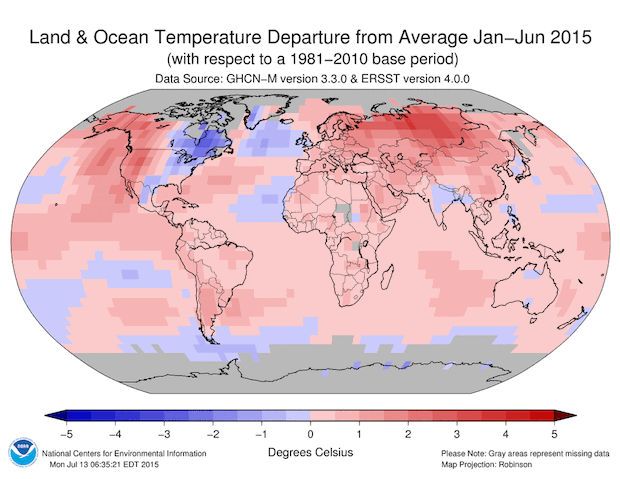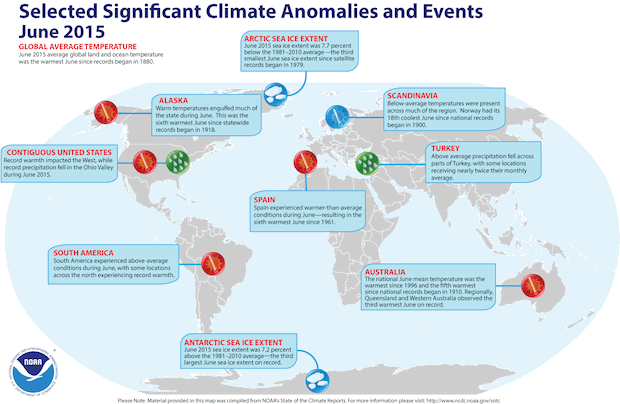Temperatures in June set another global heat record
The world endured record temperatures in June that helped make the first six months of this year the warmest ever, setting the stage for 2015 to be another unprecedented scorcher.
Temperatures across global land and ocean surfaces were 1.58 degrees above the 20th century average and the highest for June since modern record-keeping began in 1880, surpassing the previous record set last year by 0.22 degrees, according to the National Oceanic and Atmospheric Administration's monthly summary, released Monday.
On land, the temperature was 2.27 degrees above the 20th century average, which was the highest for June in the 1880-2015 record, surpassing the previous record set in 2012 by 0.11 degrees.
A similar trend was seen in the world's oceans, with average sea surface temperature 1.33 degrees above the 20th century average. Sea surface temperatures were the highest for June in the 1880-2015 record, surpassing the previous record set last year by 0.11 degrees.
The torrid conditions in June contributed to the first six months of the year being the hottest on record. The year-to-date temperature across global land and ocean surfaces was 1.53 degrees above the 20th century average. This surpassed the previous record set in 2010 by 0.16 degrees.
June was the fourth month of 2015 that broke its monthly temperature record, along with February, March, and May. The other months of 2015 were not far behind: January was second warmest for its respective month and April was third warmest.
The record heat in June played out across the globe, with Australia seeing its highest temperatures since 1996 and Alaska experiencing heat not seen since records began there in 1918. Record warmth was also seen in much of the West as well as parts of South America.
If the warming trend continues, the world will see a second year in a row with record temperatures - following confirmation last week by NOAA that 2014 was the hottest in modern times. The warmer conditions have been blamed on climate change, driven by increased greenhouse gas emissions from the burning of fossil fuels like oil and coal.
The warmer conditions also contributed to a decline in Arctic sea ice - extending a trend that has seen it decline 40 percent since the 1970s.
Arctic sea ice cover for June was 350,000 square miles below the 1981-2010 average, down 7.7 percent, but 60,000 square miles larger than the smallest June sea ice extent on record, which occurred in 2010. It was the third smallest June ice cover since records began in 1979, according to analysis by the National Snow and Ice Data Center using data from NOAA and NASA.
It also indicates that a brief respite for the Arctic is likely over. Sea ice volumes in 2013 and early 2014 increased, according to a study published Monday in Nature Geoscience, offsetting the losses in sea ice from 2010 to 2012. The reason for the recovery, according to the researchers, was due to an unusually cool summer in 2013 that was comparable to conditions in the 1990s.
Conditions this June were much different in Antarctica - continuing to defy the warming trends in other part of the world. Scientists aren't sure why the ice there is growing, though some said it might be due to cooling sea surface temperatures in the region.
Antarctic sea ice during June was 380,000 square miles above the 1981-2010 average, an increase of 7.2 percent. This was the third largest June Antarctic sea ice extent on record, though it was 140,000 square miles smaller than the record-large June extent of 2014.

